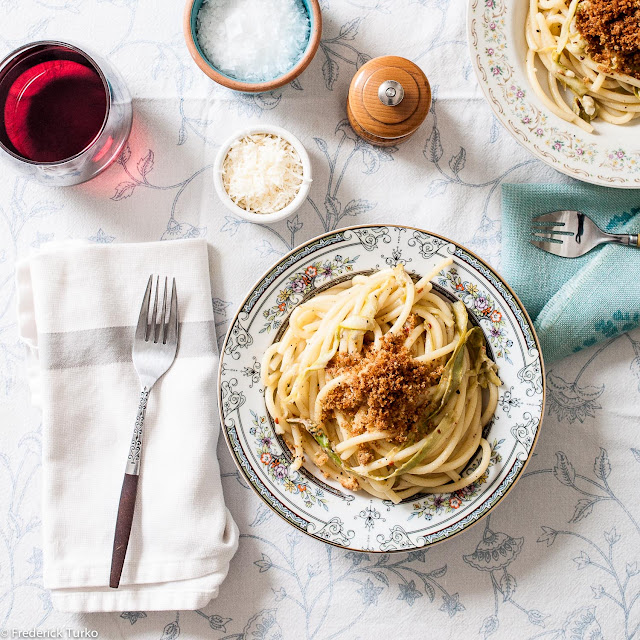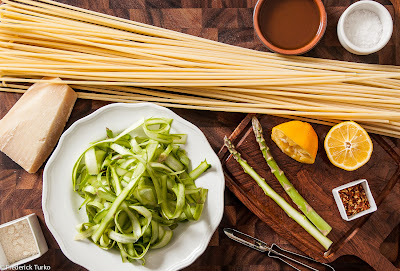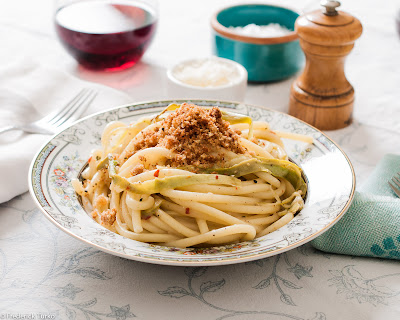Comfort Me With Bucatini.
Feb 27, 2013 in italian, san francisco, deli, asparagus, wine, old school, comfort food, pasta, pizza, recipes. Read the original on: F for Food

Growing
up in Richmond, I recall very little pasta happening in either of my parents' kitchens, except maybe pasta salad. I also don't remember going out for much Italian food back
then. I'm sure there was spaghetti and meatballs when I had dinner at
my friends' houses, but – and I could be wrong – I don't think I
ever saw it on my dining room table(s). That's weird, right? I mean,
I don't even think we did lasagna, for crying out loud. It's a
miracle I turned out alright.
That
being said, there wasn't a ton of Italian food in my life for quite
some time. After college, in the early Atlanta years, there were a couple of
EYEtalian restaurants where I dined on occasion. By EYEtalian, I mean
dimly lit rooms with red checker tablecloths, taper candles in old
chianti bottles, dishes like eggplant parmigiana, veal scaloppini, chicken marsala, penne alla vodka (one of my favorite pasta dishes to this day), mostaccioli, linguine with clam sauce, baked ziti, lasagna, and spumoni or cannoli for dessert. Oh, and both kinds of wine: red and white.
Then
in the last year or two there, a couple of Italian restaurants popped up that
became game changers. For me, at least. Actually, it was really one restaurant that later became two with the same owner. The first born, Sotto Sotto, was the higher end version of its younger sibling, Fritti. It was at Sotto Sotto where a lot of things about Italian fare really evolved in my world. In a little
restaurant in Inman Park, Atlanta, my palate got to travel from
Southern to Northern Italy for the first time. I remember tasting
delicate, handmade pastas of all shapes, sizes and consistencies,
flecked with bright and fresh surprising accents like arugula, mint,
and lemon or anchored down with braised, local duck with an aged
twelve year balsamic. There were fresh truffles, walnut sauce and
sage browned butter, which fifteen years ago was not something I saw
on menus very often. I remember having the most delicate beef
carpaccio I had ever tasted. The beef sliced so carefully, so thinly,
that it essentially melted on my tongue. And then when the little
sister, Fritti, came along, I was introduced to the lightest,
freshest calamari fritti, garnished only with fresh lemon, and their
crimini and portobello mushrooms, lightly fried in rice
flour batter with white truffle oil. Most importantly, it was the first
time I became acquainted with Neapolitan pizza. And burrata.
Best
of all, I lived a mere two blocks away. Even bester, two of my
girlfriends and my then boyfriend worked there.
And
so an Italian food lover was born.
In
the eleven years that I have lived here in LA, though, I don't make pasta at home as much as other things, I would say that
my go to meal out is easily for Italian food. More often than not,
what I crave is the Northern Italian fare; the fine handmade pastas
with fresh, seasonal produce, nuanced flavors and elegant sauces,
and almost always I will opt for Neapolitan pies to that of any
other. That said, I would never turn down a dinner at Dan Tana's. Who
wouldn't want a side of spaghetti with their spaghetti?
But
here's the thing, a couple of years ago I came across a recipe in The Week for a dish called Cacio e Pepe. Its scant few ingredients and
seemingly whimsical and simple process tempted me. The recipe called
for a long pasta (in this case, bucatini), Parmesan cheese, extra
virgin olive oil, Kosher salt and lots and lots of freshly cracked
black pepper. After I tried to make it the first time, and failed, I
started to read about the recipe. I realized that this dish
exemplifies the complexity of pan sauce precision. Of course! This is
one of those less-is-more, minimalist recipes by which cooks are
measured – and as I read on, I learned that no two chefs agree on
how to do it just right.
And,
it's a Roman dish... making it kind of EYEtalian!
After
that, my interest was piqued. If I saw it on a menu, I ordered it.
And, for the most part, folks were using the bucatini. So, my only occasion, other than my own kitchen defeat, for both the bucatini and the cacio e pepe had been when dining out.
Then
I met Fred. And on our third date, he invited me to his place to cook
me dinner. I remember thinking, “Uh, oh. He has no idea what he's
gotten himself into. Be nice, be nice, be nice.†Beyond all of the
bells, whistles (the right kind, not the gaudy kind), and the t s
crossed and i s dotted, there he was, in his kitchen, with a YouTube
video playing on his iPad illustrating how to make cacio e pepe. And before you
ask, no, he had no idea. This was all Fred.
I
remember thinking it was going to be a disaster. If I couldn't make
it right, and it was such a cornerstone for great chefs, how was he
going to do it?
It
was perfect. It is still the best version of cacio e pepe (and with
bucatini, mind you) I have had to date. I'm serious!
And
so, not only did cacio e pepe become even more pivotal to me, but
bucatini, in particular did as well. Unfortunately, I have only
stumbled upon it a few times here in LA since I began this obsession.
And I look. Once I saw it at the Silverlake Farmers' Market, but it
seemed a little pricey. Anyway, on a recent trip to San Francisco,
Fred and I poked into our favorite EYEtalian deli and grabbed every
kind of bucatini they had. That would be five (5) different brands of
bucatini.
And
a couple of nights ago I made a dish with the prettiest and fanciest
of our bucatinis. It was a type of a cacio e pepe, but I added shaved
asparagus stalks, a single clove of garlic, some red pepper flakes,
lemon and I topped everything with fresh breadcrumbs. I also used two
cheeses; a Grana Padano, for its velvety texture, and Pecorino, for
its sharpness. Other than adding the extras, the concept and the
technique were no different than the original cacio e pepe.
I'd
like to tell you how romantic it was that we made this, our very
special dish together. I'd like it to seem like we savored that last
strand of bucatini like the Lady and the Tramp. But we were really
just so excited and so hungry, that we pretty much inhaled our big
bowls of pasta and glasses of chianti. Just-a like-a Mama would-a
like-a.
Bucatini with Shaved Asparagus & Fresh Breadcrumbs
Serves
4
Ingredients:
2
thick slices hearty bread, torn into about 1-inch pieces

extra
virgin olive oil

1
pound bucatini

red
pepper flakes

1
clove garlic, minced

2
bundles asparagus, shaved

The
juice of 1 lemon

1/4
cup mixed grated Grana Padano & Pecorino cheeses
Kosher
salt, and freshly cracked black pepper
Directions:
Preheat
oven to 400 degrees. Pulse bread in food processor to make
bread crumbs. Spread the crumbs on a small baking tray.Â
Drizzle with olive oil and a pinch of salt; toss. Toast for 15
minutes, or until golden brown.
Meanwhile,
bring a large pot of salted water to a boil. Cook bucatini
until al dente. Reserve a bit of the cooking water.
Just
before the pasta finishes cooking, heat about a tablespoon of olive
oil in a skillet. Add garlic and a pinch or two of red pepper
flakes and cook until fragrant, about a minute. Add asparagus
and a pinch of salt; cook until the asparagus until slightly
softened. Add juice of the lemon. Toss.
Add
the cooked bucatini and parmesan to the skillet with the asparagus;
toss to coat. Add reserved cooking water a tablespoon at a
time, if necessary, to achieve your desired consistency. Serve,
topped with toasted breadcrumbs.
Printable recipe.
One year ago:Â Grilled Oysters with Garlicky, Lemony, Buttery Sauce
Two years ago: I Left My Heart in San Fran-cheesy; Part 3, The Final Chapter
Three years ago: Chili with Beef & Bacon
Five years ago: Angelini Osteria
Printable recipe.
One year ago:Â Grilled Oysters with Garlicky, Lemony, Buttery Sauce
Two years ago: I Left My Heart in San Fran-cheesy; Part 3, The Final Chapter
Three years ago: Chili with Beef & Bacon
Five years ago: Angelini Osteria
Read the original on: F for Food
F for Food, Elliott Shaffner
I write about all things food. And wine. There is often wine. I eat and drink and write my way through recipes and restaurants everywhere I go in the world, and in my kitchen.






